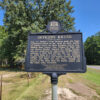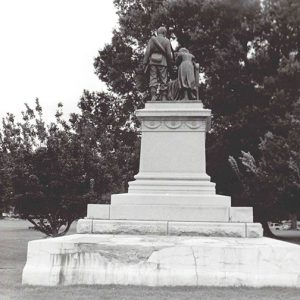calsfoundation@cals.org
Monument to Confederate Women
With the rise of memorial groups in the late nineteenth and early twentieth centuries, commemorating the sacrifice of those who fought in the Civil War became a major theme of popular remembrance. Recognizing women’s sacrifices during the war was a large part of this. On May 1, 1913, Little Rock (Pulaski County) became home to the South’s second monument to the women of the Confederacy (the first being erected in South Carolina the previous year). The monument is cast in bronze upon a marble, concrete, and granite base. It depicts a woman seated, a young boy to her right holding a military-style drum, and a young girl to her left, all bidding farewell to a standing husband and father departing to fight in the war. The father is the dominant figure, and the mother is the focal point, with all four characters connected to or holding on to each other. The monument is located in front of the Arkansas State Capitol building in Little Rock. The monument was paid for by both the United Confederate Veterans (UCV) and the State of Arkansas, with the latter paying the majority of the cost.
The UCV began plans for a monument to the women of the Confederacy at its state annual reunion at Fort Smith (Sebastian County) held October 17–19, 1906. A committee was established to locate the funds necessary to build the monument. The committee included J. M. Lucey (chairman), Dan W. Jones, Charles Coffin, V. Y. Cook, J. H. Berry, and J. Kellogg (secretary). The original plan at the Arkansas convention was to arrange the erection of “at least one monument in each of the Southern States to commemorate the heroism of the Southern women in the Civil War period.” The committee began work by collecting reminiscences of Arkansas women about the Civil War to create a compilation of memories to inspire action for the memorial. These reminiscences were compiled into a book that was sold (paper copy 50 cents, cloth $1.00) to raise money for the monument. The book gathered writings from all over Arkansas, including the memories of many women who experienced the Civil War as well as men who told stories of brave women during war time.
The statue was designed by J. Otto Schweizer, who was born in Zurich, Switzerland, in 1863. He enrolled in the Royal Academy of Art in Dresden, Germany, in 1882 and immigrated to the United States in 1894. Schweizer was contracted to design several Civil War monuments before the memorial in Little Rock. The Little Rock monument is Schweizer’s only work of a Confederate theme, and it is his only sculpture commemorating women. The monument was added to the National Register of Historic Places in 1996.
The monument plaque reads as follows:
To The Confederate Women Of Arkansas 1861–1865
“Whose Pious Ministrations To Our Wounded Soldiers Soothed The Last Hours Of Those Who Died For The Object Of Their Tenderest Love; Whose Domestic Labors Contributed Much To Supply The Wants Of Our Defenders In The Field; Whose Jealous Faith In Our Cause Shone A Guiding Star, Undimmed By The Darkest Clouds Of War; Whose Fortitude Sustained Them Under All The Privations To Which They Were Subjected; And Whose Patriotism Will Teach Their Sons To Emulate The Deeds Of Their Sires.”
This Monument Is Erected By The State Of Arkansas And The Confederate Veterans
For additional information:
Confederate Women of Arkansas in the Civil War: Memorial Reminiscences. Rev. ed. Fayetteville, AR: M&M Press, 1993.
“Elaborate Program Marks Unveiling.” Arkansas Gazette, May 2, 1913, pp. 1, 9.
Elledge, Zachary Lynn. “Defeat and Memory at the Arkansas State Capitol: The Little Rock Monument to the Women of the Confederacy, 1896–1914.” MA thesis, Arkansas State University, 2015.
Jockers, Ernst. J. Otto Schweizer: The Man and His Work. Philadelphia: International Printing Co., 1953.
Latimer, Franklin Allen. “Arkansas Listings in the National Register of Historical Places: The Confederate Soldiers Monument and Monument to Confederate Women in Little Rock.” Arkansas Historical Quarterly 60 (Autumn 2001): 305–310.
Logan, Charles Russell. “Something So Dim It Must Be Holy: Civil War Commemorative Sculpture in Arkansas, 1886–1934.” Little Rock: Arkansas Historic Preservation Program, 1997. Online at https://www.arkansasheritage.com/arkansas-preservation/programs/publications (accessed April 18, 2024).
“Monument to Confederate Women.” National Register of Historic Places nomination form. On file at Arkansas Historic Preservation Program, Little Rock, Arkansas. Online at https://www.arkansasheritage.com/arkansas-historic-preservation-program (accessed April 18, 2024).
United Confederate Veterans Association Records. Special Collections. Louisiana State University Libraries, Baton Rouge, Louisiana.
Zachary Elledge
Jonesboro, Arkansas
 Camden Confederate Monument
Camden Confederate Monument Civil War Markers and Memorials
Civil War Markers and Memorials Early Twentieth Century, 1901 through 1940
Early Twentieth Century, 1901 through 1940 Historic Preservation
Historic Preservation Lost Cause Myth of the Confederacy
Lost Cause Myth of the Confederacy Monument to Confederate Women
Monument to Confederate Women  Monument to Confederate Women
Monument to Confederate Women  Monument to Confederate Women
Monument to Confederate Women  Monument to Confederate Women
Monument to Confederate Women 




Comments
No comments on this entry yet.